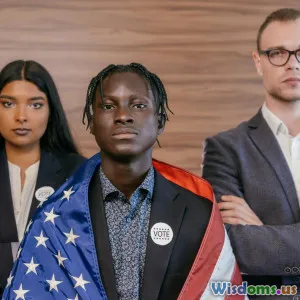
What Young Adult Readers Deserve: A Conversation on Inclusivity
7 min read Exploring the vital need for inclusivity in YA literature to empower diverse young voices and foster understanding. (0 Reviews)
What Young Adult Readers Deserve: A Conversation on Inclusivity
Young adult (YA) literature has long been a mirror and a window for its readers—a source of reflection on their own lives as well as a portal into experiences different from their own. But what happens when that mirror is fractured, offering only select images of identity, culture, and experience? What young adult readers truly deserve is a literary landscape that embraces inclusivity—stories that authentically represent the rich diversity of our world and foster empathy across lines of difference. This conversation on inclusivity in YA literature is essential not only for the well-being of young readers but for the health of society as a whole.
Why Inclusivity Matters in YA Literature
Reflecting Reality, Validating Identity
For many young readers, books are a primary way to see themselves validated. According to a 2020 Cooperative Children's Book Center (CCBC) study, only about 16% of children’s books featured characters from underrepresented racial or ethnic groups, highlighting a significant gap. When young adults encounter characters who look like them, share their background, or wrestle with similar issues—be it mental health, gender identity, or economic hardship—they experience affirmation of their worth and complexity.
Take, for example, the widespread impact of Angie Thomas's "The Hate U Give," which portrays a Black teenage girl grappling with police violence and activism. The novel doesn’t just entertain; it empowers readers of color to feel seen and educates others on systemic injustice. Likewise, LGBTQ+ representation in works like Becky Albertalli’s "Simon vs. the Homo Sapiens Agenda" provides much-needed visibility and normalizes queer identities.
Building Empathy and Cultural Awareness
Inclusivity extends benefits beyond identity validation; it cultivates empathy among readers. Diverse stories function like bridges, reducing prejudice and opening readers' minds to multifaceted lives. Research by the Literary Diversity Alliance shows that exposure to minority narratives corresponds with increased empathy and decreased stereotyping among adolescents.
For instance, "American Born Chinese" by Gene Luen Yang uses graphic storytelling to explore the Asian American adolescent experience, challenging stereotypes and encouraging readership empathy regardless of background. When young people absorb nuanced stories, they become more prepared for a pluralistic society.
Current Challenges to Inclusivity in the YA Industry
Publishing Gatekeeping and Market Limitations
Despite gains, structural barriers in the publishing industry stall inclusivity progress. Data from Lee & Low Books reveals that minority authors receive disproportionately fewer book deals and marketing support. This disparity impacts what books reach shelves and how widely.
Editors and agents sometimes perceive diverse stories as niche or market-risky, even though the success of titles like "The Hate U Give" and "Children of Blood and Bone" by Tomi Adeyemi contradicts such beliefs. Moreover, some authors face tokenism or pressure to reduce cultural specificity to appeal to wider audiences—a disservice to authenticity.
Stereotyping and Misrepresentation
When inclusivity efforts are half-hearted, they risk reinforcing stereotypes rather than dismantling them. The presence of a diverse character is insufficient if portrayed superficially or inaccurately.
On the other hand, projects such as Own Voices publishing—authors telling their own marginalized stories—address these concerns. For instance, Elizabeth Acevedo’s "The Poet X" speaks from a Dominican American teen's viewpoint, offering an intimate look into Afro-Latina identity and family struggles.
Moving Forward: What Can Be Done?
Encouraging Inclusive Publishing Practices
Publishers must commit to diversifying their editorial teams and author portfolios. Outreach programs that mentor writers from marginalized communities and inclusive submission guidelines can open doors.
Libraries and bookstores also play gatekeeper roles. Inclusive reading lists and visible diverse collections affect reader discovery and awareness. Initiatives like the #WeNeedDiverseBooks campaign have raised the industry's consciousness, showing tangible demand for inclusion.
Equipping Educators and Parents
Educators should be provided with resources to select diverse YA literature thoughtfully and create safe spaces for discussing complex topics contained within. Parents can encourage young readers' exploration of different cultures while supporting them in finding books that resonate personally.
Empowering Youth Voices
Young readers themselves are powerful advocates for inclusivity. Platforms such as BookTube, social media communities, and grassroots reading groups help amplify voices demanding authentic representation.
Guest columns and interviews with young book bloggers showcase the hunger for stories that mirror the multiplicity of youth experiences, pushing industry shifts from the ground up.
Conclusion: The Promise of Inclusive YA Literature
Inclusivity in young adult literature is not just a trend—it’s a necessity for fostering a generation of thoughtful, empathetic, and empowered individuals. Young readers deserve stories where they find belonging and insight into others’ lives. Real change requires persistence from publishers, educators, caregivers, and readers themselves.
As the saying goes, "You can’t be what you can’t see." Inclusive literature ensures that every young person sees themselves reflected and embraces the vast tapestry of human experience. This conversation is ongoing, but its rewards—justice, understanding, and inspiration—are well worth the effort.
References
- Cooperative Children's Book Center (CCBC), 2020 Statistics.
- Lee & Low Books Diversity Baseline Survey, 2019.
- The Literary Diversity Alliance, Empathy Studies, 2021.
- #WeNeedDiverseBooks Movement.
Whether you are a reader, writer, educator, or industry professional, it’s time to listen to what young adults deserve: inclusive stories that truly represent their world.
Rate the Post
User Reviews
Popular Posts





















